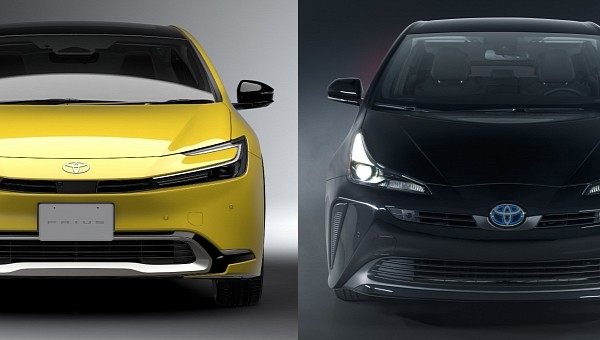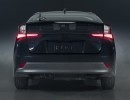Presented at the New York International Auto Show in 2003, the second-generation Prius marked a radical departure from the original by dropping the four-door sedan body style for a five-door liftback. The Kammback-styled rear end improved the drag coefficient to 0.26 to the detriment of styling, which is a big problem for the world’s best-selling hybrid.
Better late than never, the Japanese company redesigned the Prius for the 2023 model year with cleaner styling for the rear end. Toyota has also worked its magic on the design of the taillights. Dropping the unpainted plastic trim in favor of a gloss-black element of the rear bumper helps too.
Even the tailpipe is neatly hidden behind the rear bumper, and Toyota refrained from giving the all-new Prius a faux exhaust finisher. Admired from the side, it’s hard to ignore the sharper A-pillars that enable the steeper rake of the windshield. Rather than dialing up the aggression, Toyota focused on the curvature of the roof line. It has also relocated the rear exterior handles from the doors to the areas right next to the C pillars.
Further back, Toyota used body-color paint instead of black trim for the C pillars, which resulted in a more cohesive design. The front end, however, is the biggest upgrade from the previous generation. From the slim signature lighting to the way the headlights are integrated into the front bumper and front fenders, the XW60 is a huge improvement over the outgoing XW50.
The lower grille might not be to everyone’s liking, but hey, no design is perfect in this industry. Stepping inside reveals a digital instrument cluster located on the dash top right ahead of the driver. The previous-generation Prius features a centrally-mounted instrument cluster that always looked a bit meh in relation to the touchscreen infotainment system. The touchscreen grew in diagonal, lost a few buttons while retaining the volume knob, and boasts much-needed hardware and software upgrades.
The shifter is a very different affair as well, and the buttons on the steering wheel are better integrated than before. As opposed to certain vehicles we shall not name, the Prius still features physical buttons for the air conditioning and heater, which is the best interface possible for HVAC controls, given our muscle memory. What’s more, Toyota kept the front quarter windows to improve visibility when negotiating a busy intersection.
Even the tailpipe is neatly hidden behind the rear bumper, and Toyota refrained from giving the all-new Prius a faux exhaust finisher. Admired from the side, it’s hard to ignore the sharper A-pillars that enable the steeper rake of the windshield. Rather than dialing up the aggression, Toyota focused on the curvature of the roof line. It has also relocated the rear exterior handles from the doors to the areas right next to the C pillars.
Further back, Toyota used body-color paint instead of black trim for the C pillars, which resulted in a more cohesive design. The front end, however, is the biggest upgrade from the previous generation. From the slim signature lighting to the way the headlights are integrated into the front bumper and front fenders, the XW60 is a huge improvement over the outgoing XW50.
The lower grille might not be to everyone’s liking, but hey, no design is perfect in this industry. Stepping inside reveals a digital instrument cluster located on the dash top right ahead of the driver. The previous-generation Prius features a centrally-mounted instrument cluster that always looked a bit meh in relation to the touchscreen infotainment system. The touchscreen grew in diagonal, lost a few buttons while retaining the volume knob, and boasts much-needed hardware and software upgrades.
The shifter is a very different affair as well, and the buttons on the steering wheel are better integrated than before. As opposed to certain vehicles we shall not name, the Prius still features physical buttons for the air conditioning and heater, which is the best interface possible for HVAC controls, given our muscle memory. What’s more, Toyota kept the front quarter windows to improve visibility when negotiating a busy intersection.













